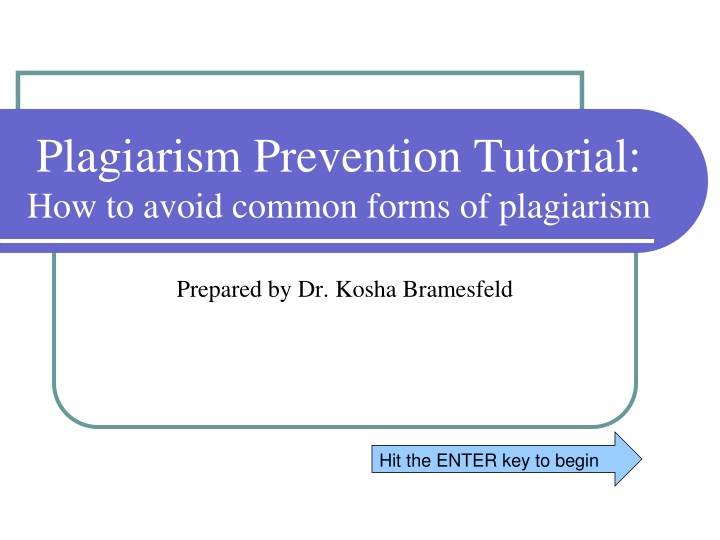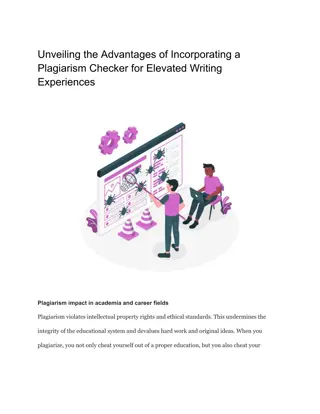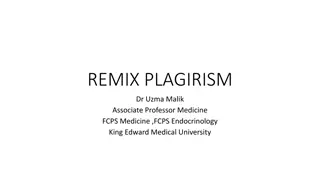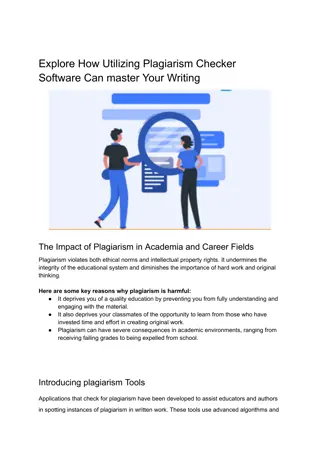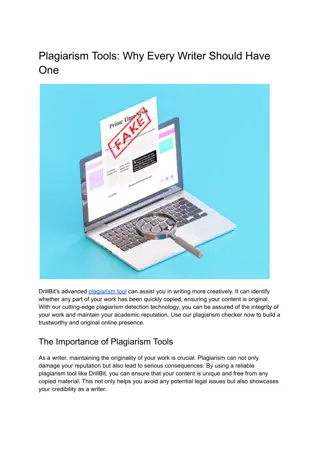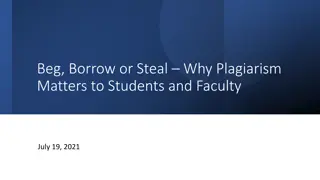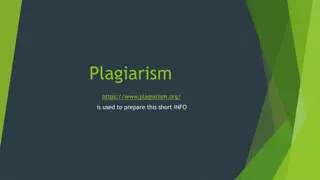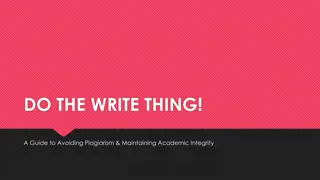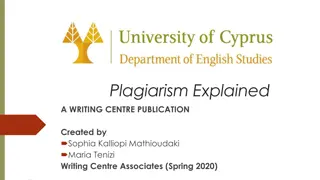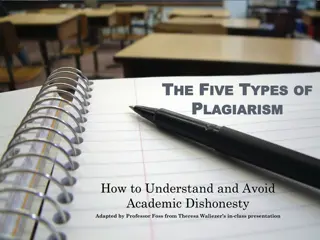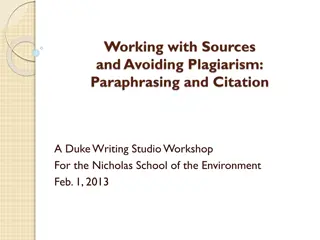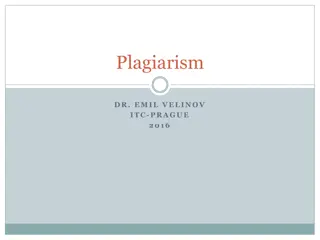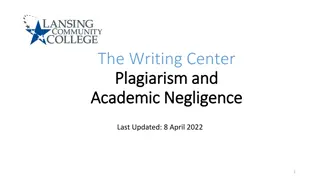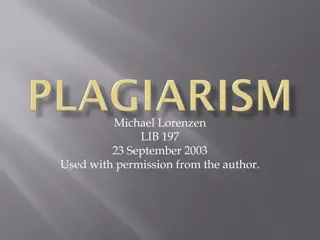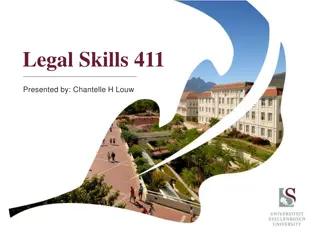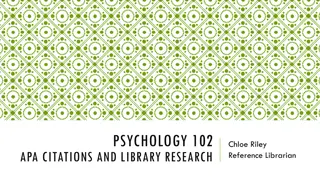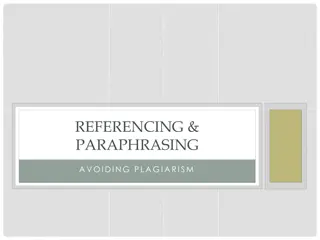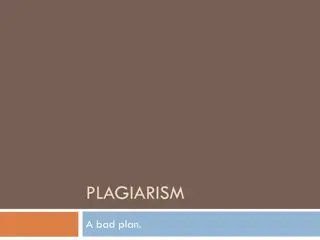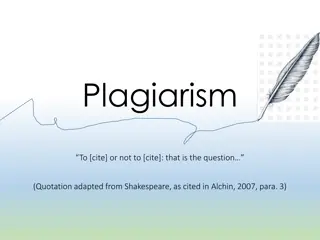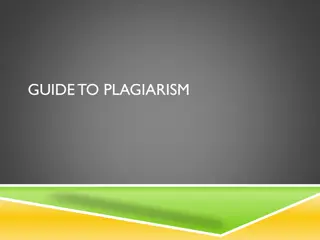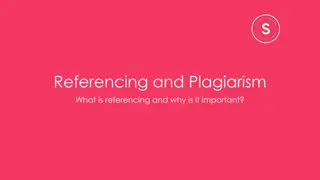Plagiarism Prevention Tutorial: How to Avoid Common Forms of Plagiarism
This tutorial by Dr. Kosha Bramesfeld provides valuable insights on understanding, preventing, and avoiding plagiarism. Learn about the various forms of plagiarism, the importance of citing sources, using APA style, paraphrasing, and creating references to maintain academic integrity. Avoid the severe consequences of plagiarism by following these guidelines.
Download Presentation

Please find below an Image/Link to download the presentation.
The content on the website is provided AS IS for your information and personal use only. It may not be sold, licensed, or shared on other websites without obtaining consent from the author.If you encounter any issues during the download, it is possible that the publisher has removed the file from their server.
You are allowed to download the files provided on this website for personal or commercial use, subject to the condition that they are used lawfully. All files are the property of their respective owners.
The content on the website is provided AS IS for your information and personal use only. It may not be sold, licensed, or shared on other websites without obtaining consent from the author.
E N D
Presentation Transcript
Plagiarism Prevention Tutorial: How to avoid common forms of plagiarism Prepared by Dr. Kosha Bramesfeld Hit the ENTER key to begin
Overview of this tutorial This tutorial is organized into the following sections: What is Plagiarism? Citing Sources Using APA Style Paraphrasing Information Making it Your Own Preparing a List of References Conclusions ENTER
What is Plagiarism? Overview: This section of the tutorial defines plagiarism and identifies the common errors that often result in plagiarism. ENTER
What is plagiarism? When you are asked to turn in written work that draws on the ideas and findings of others, you will want to make sure to give credit where credit is due. This tutorial is designed to help you learn how to do this and how to avoid plagiarism. Plagiarism is when you present the information, ideas, or words of someone else in a manner that a reader of your paper would think that the information, ideas, or words were your own. ENTER
Did you know? Although many acts of plagiarism occur intentionally (with the intent and knowledge that one is being misleading), plagiarism can also occur unintentionally (without intent or knowledge), as a consequence of carelessness on the part of the writer. Whether you intend to plagiarize or you plagiarize as a consequence of carelessness, plagiarism is unethical, against University policy, and very serious. If you are caught plagiarizing you can fail an assignment, a course, or even be dismissed from your program! ENTER
Plagiarism comes in many forms! Plagiarism comes in many forms. For example, the website Plagiarism.org (n.d.) identifies 10 common types of plagiarism, including: Plagiarism.org (n.d.) Types of Plagiarism. Reproduced with permission from: http://www.plagiarism.org/plagiarism-101/types-of-plagiarism/ ENTER
Plagiarism comes in many forms! Plagiarism.org (n.d.) Types of Plagiarism. Reproduced with permission from: http://www.plagiarism.org/plagiarism-101/types-of-plagiarism/ ENTER
Plagiarism comes in many forms! Other resources define similar types of plagiarism, although they may use different terms to describe those concepts. No matter the type, or term, used to describe it, incidents of plagiarism tend to involve one or more of the following errors: Failure to properly cite sources of information. Overreliance on the words or organizational structure of someone else s work. Overuse of the work or ideas of other people, at the expense of one s own unique contributions. ENTER
Plagiarism prevention basics To help you avoid plagiarism, this tutorial will teach you how to: Cite sources using APA style. Paraphraseinformation so that you are correctly citing and using the information and ideas of others, without over-relying on the exact words or organizational structure of the original. Make it your own, by contributing your own ideasto the paper (while still properly citing) so that you are not over-relying on the work and ideas of other people. Create a list of references so that someone who is reading your paper can follow up on any sources that you cite within your paper. ENTER
Citing Sources Using APA Style Overview: This section of the tutorial introduces the APA citation style and provides examples of how to cite information in text. ENTER
Citing sources using APA style Citing means to indicate the source of information when that information is used within a paper (i.e., in-text ). You should cite the work of any individual whose ideas, theories, or research have directly influenced your work. Psychology uses the citing style of the American Psychological Association (APA). The next few slides cover the basics of this common citing style. American Psychological Association (2010). Publication manual of the American Psychological Association (6th ed.). Washington, DC: Author. ENTER
Citing sources using APA style To cite a source in APA style you generally need to include: The last name of all authors The publication year A page number for any direct quotations ENTER
Citing sources using APA style The citation can appear as part of a sentence (with the year of publication appearing in parentheses): As noted by Myers (2013, p. 45), every idea, every mood, every urge is a biological happening. Or, the citation can appear at the end of the sentence (with the author s last name and the publication year appearing in parentheses): Every idea, every mood, every urge is a biological happening (Myers, 2013, p. 45). ENTER
Citing one or two authors If there is one author to a source, you include the last name of that one author every time you cite that source. Wilson (2005) (Wilson, 2005). If there are two authors, you include the last name of both authors every time you cite that source: Wilson and Brekke (1994) . (Wilson & Brekke, 1994). ENTER
Citing three to five authors If there are three to five authors, you include the last name of all authors the first time that you cite the source: Wilson, Damiani, and Shelton (2002) (Wilson, Damiani, & Shelton, 2002). You then shorten the citation to the first author s last name and abbreviate the remaining authors last names as et al. for each additional time you cite that source: Wilson et al. (2002) (Wilson et al., 2002). ENTER
Citing six or more authors If there are six or more authors, you include the last name of the first author and the abbreviation et al. for the other authors each time that you cite the source (including the first time). Wilson et al. (1993) (Wilson et al., 1993). ENTER
Citing websites If you wish to cite a website, include the author (or organization) and year of publication. If a year of publication is not available, indicate no date using the abbreviation (n.d.). If the author (or organization) is unknown, use the first few words of the title enclosed in quotation marks. If quoting, include the paragraph number (para.) of the quotation. (Lee, 2010) (Plagiarism.org, n.d.) The Writer's Handbook (2012, para. 3) states, Lee, C. (2010). How to cite something you found on a website in APA style [blog post]. Retrieved from http://blog.apastyle.org/apastyle/2010/11/how-to-cite- something-you-found-on-a-website-in-apa-style.html. ENTER
Citing secondary sources Sometimes you may want to cite Person A s work, but you only know about it from reading a description in Person B s work. Person B is the secondary source. Because you do not know that Person B accurately reported Person A s ideas, or that Person B did not plagiarize from Person A, you should find the original source of Person A s work and cite Person A. Please know that by citing a source within your paper, you are indicating that you have actually consulted that source. If you cite information from a secondary source rather than consulting the original source, you could be plagiarizing! ENTER
Citing secondary sources Still, it may not always be possible to track down an original source. For example, the 2010 APA Publication Manual quotes Bentley et al. (1929) in describing how the manual first began in 1929. If you wanted to include this information in your own writing and were unable to find the original source, you would need to make it clear that you were using a secondary source by indicating the Original Author (year; as cited in or as quoted by Secondary Source, year): The APA Publication Manual originated as a standard of procedure (Bentley et al., 1929, p. 57; as quoted by the American Psychological Association, 2010, p. 3). American Psychological Association (2010). Publication Manual of the American Psychological Association (6th ed.). Washington, DC: Author. ENTER
Quoting Quoting is using the exact phrase or wording of someone else. APA (2010, p. 170) notes that, when quoting, always provide the author, year, and specific page citation or paragraph number. Quotes of less than 40 words should appear in the text with double quotation marks. Quotes of more than 40 words should appear as a freestanding block of text, without quotation marks. The citation information can be used to introduce the quote, or it can be placed at the end of the quote. In either case, the quote should end with the page or paragraph number (APA, 2010). An example of a block quote is presented on the next page. The quote is from The Writer s Handbook (2012, para. 3) and it discusses when you should quote from a source. ENTER
When to quote As quoted directly from The Writer's Handbook (2012): In research papers, you should quote from a source to show that an authority supports your point to present a position or argument to critique or comment on to include especially moving or historically significant language to present a particularly well-stated passage whose meaning would be lost or changed if paraphrased or summarized (para. 3) The Writer s Handbook: Avoiding Plagiarism (2012, July 2). Paraphrasing vs. quoting An explanation. Retrieved from https://writing.wisc.edu/Handbook/QPA_PorQ.html ENTER
To quote or not to quote? Although quoting may be necessary in some situations (as indicated on the previous slide), quoting is not the best option for avoiding plagiarism. Even when quoting and citing correctly, a paper can still be considered plagiarized if a student quotes information that he or she does not understand, if information is presented out of context or in a misleading fashion, or if a student relies too heavily on the quoted words of another when writing a paper. Given this, you should only quote when absolutely necessary. ENTER
If not quoting, then what? If you should quote only when necessary, what is the alternative? The alternative is the use of paraphrasing. Paraphrasing is putting someone else s ideas into your own words, while still giving credit where credit is due. Many students are surprised to learn that paraphrasing is an acceptable way to use the information of others. In fact, in many ways, paraphrasing is preferable to quoting because it reflects your own personal understanding of the material. The next section of this tutorial discusses why paraphrasing is generally preferable to quoting, discusses how to properly paraphrase information, and provides examples of properly paraphrased passages. ENTER
Paraphrasing Information Overview: This section of the tutorial provides information on how to properly paraphrase information from other sources. ENTER
Quoting out of context Assume that a student is asked to summarize the findings of an article written by Gu guen (2012). The student writes the following: In the study by Gu guen (2012), participants were randomly assigned to one of four between subject color conditions: red, blue, green, and white (n = 30 in each condition). They were informed that the experiment was to study how men judged photographs representing women (p. 262). With the attractiveness rating, a main effect was found (F (3, 116) = 4.27, p = .007, 2 = .08). Post-hoc comparisons revealed that red was different from blue and green, whereas no further statistical difference was found (p. 263). Gu guen, N. (2012): Color and women attractiveness: When red clothed women are perceived to have more intense sexual intent. The Journal of Social Psychology, 152, 261-265. http://dx.doi.org/10.1080/00224545.2011.605398 ENTER
Quoting out of context There are numerous problems with the prior passage that could be grounds for accusations of plagiarism: First, the quotations do not make any sense out of context and include details that are not relevant to the summary. Second, unless the student has training in research methods and statistics, it is unlikely that the student fully understands the procedures and statistical results that she is quoting. Third, the student s summary of the article does not really reflect her own understanding of the article. Rather, she is relying entirely on the words of the author to formulate her the summary (and therefore she cannot really call the summary her own ). ENTER
The power of paraphrasing Paraphrasing is a technique that allows a writer to rephrase information from another source in a manner that reflects the writer s own understanding of that information, while still giving credit where credit is due. Paraphrasing is advantageous over quoting, as it allows the writer: To summarize the key aspects of a source. To place the information from a source into context. To integrate information from a source with the writer s own thoughts and ideas. ENTER
The power of paraphrasing The passage below paraphrases the information that was previously quoted. This paraphrase makes a lot more sense! Gu guen (2012) created photos showing a woman wearing a red shirt, blue shirt, green shirt, or white shirt. Everything else in the photo was the same. To examine if the color of the shirt influenced whether or not men found the woman attractive, Gu guen had male participants view one of the photos of the woman and had them rate her attractiveness. The men found the woman most attractive when she was wearing the red shirt, as compared to when she was wearing the blue shirt or the green shirt. These results suggest that the color of a woman s clothing can influence perceptions of attraction. Gu guen, N. (2012): Color and women attractiveness: When red clothed women are perceived to have more intense sexual intent. The Journal of Social Psychology, 152, 261-265. http://dx.doi.org/10.1080/00224545.2011.605398 ENTER
The process of paraphrasing The Purdue Owl (2010) provides tips for successful paraphrasing. Rather than quoting this information directly, I can quickly paraphrase the key aspects of this information as follows: According to the Purdue Owl (2010), to paraphrase a passage of information, the student should first study that information until he or she has a solid understanding of the material. Then, without consulting the original, the student should rewrite the information in a way that reflects the student s own words, organization, and understanding. Even when paraphrasing, the student must still cite the source of the original information! Purdue Owl. (2010, April 21). 6 steps to effective paraphrasing. Retrieved from: https://owl.english.purdue.edu/owl/resource/619/01/ ENTER
You Try It! Presented below is an excerpt from p. 45 in David Myers (2013) Psychology textbook. Paraphrase this information to develop a response to the question: Why is biology so important to the study of psychology? Study the information until you fully understand the meaning. Your every idea, every mood, every urge is a biological happening. You love, laugh, and cry with your body. Without your body your genes, your brain, your appearance you are, indeed, nobody. Myers, D. G. (2013). Psychology (10th ed., in Modules). New York, NY: Worth. ENTER
You Try It! Without consulting the original, rewrite the information into your own words. Original: Your every idea, every mood, every urge is a biological happening. You love, laugh, and cry with your body. Without your body your genes, your brain, your appearance you are, indeed, nobody (Myers, 2013, p. 45). Myers, D. G. (2013). Psychology (10th ed., in Modules). New York, NY: Worth. ENTER
You Try It! Double check your rewrite with the original. Does your summary reflect your own words, organization, and understanding? Original: Your every idea, every mood, every urge is a biological happening. You love, laugh, and cry with your body. Without your body your genes, your brain, your appearance you are, indeed, nobody (Myers, 2013, p. 45). Myers, D. G. (2013). Psychology (10th ed., in Modules). New York, NY: Worth. ENTER
You Try It! Did you properly cite Myers (2013, p. 45) to credit your source? Original: Your every idea, every mood, every urge is a biological happening. You love, laugh, and cry with your body. Without your body your genes, your brain, your appearance you are, indeed, nobody (Myers, 2013, p. 45). Myers, D. G. (2013). Psychology (10th ed., in Modules). New York, NY: Worth. ENTER
You Try It! Save your paraphrased response. You will submit this paraphrase as part of the Plagiarism Prevention Quiz. Original: Your every idea, every mood, every urge is a biological happening. You love, laugh, and cry with your body. Without your body your genes, your brain, your appearance you are, indeed, nobody (Myers, 2013, p. 45). Myers, D. G. (2013). Psychology (10th ed., in Modules). New York, NY: Worth. ENTER
Test Yourself Presented below is an excerpt from a New York Times article by Belluck (2009). Belluck s article considers whether it is ethical for scientists to use their own children as research participants. On the next few slides, see if you can identify if this excerpt has been properly paraphrased Original: Some research methods are clearly benign; others, while not obviously dangerous, might not have fully understood effects. Ethicists said they would consider participation in some projects acceptable, even valuable, but raised questions about the effect on the child, on the relationship with the parent, and on the objectivity of the researcher or the data (Belluck, 2009, para. 9). Belluck, P. (2009, January 18). Test subjects who call the scientist mom or dad. The New York Times. Retrieved from: http://www.nytimes.com/2009/01/18/health/18iht-18kids.19450084.html. ENTER
Is this paraphrased correctly? As noted by Belluck (2009, para. 9), it may not be ethical to use children as research subjects because even though some methods are clearly not dangerous; others might not have fully understood effects. Ethicists would consider participation in some projects acceptable, but raised questions about the relationship with the parent and the effect on the child. They also questioned the objectivity of the researcher. Original: Some research methods are clearly benign; others, while not obviously dangerous, might not have fully understood effects. Ethicists said they would consider participation in some projects acceptable, even valuable, but raised questions about the effect on the child, on the relationship with the parent, and on the objectivity of the researcher or the data (Belluck, 2009, para. 9). ENTER
Rearranging paraphrasing! The student has not properly paraphrased. Rather, he has just rearranged some of the words. As noted by Belluck (2009, para. 9), it may not be ethical to use children as research subjects because even though some methods are clearly not dangerous; others might not have fully understood effects. Ethicists would consider participation in some projects acceptable, but raised questions about the relationship with the parent and the effect on the child. They also questioned the objectivity of the researcher. Original: Some research methods are clearly benign; others, while not obviously dangerous, might not have fully understood effects. Ethicists said they would consider participation in some projects acceptable, even valuable, but raised questions about the effect on the child, on the relationship with the parent, and on the objectivity of the researcher or the data (Belluck, 2009, para. 9). ENTER
Rearranging paraphrasing! Paraphrasing is not simply rearranging the words of the original source. True paraphrasing involves the rewording of an idea so that it reflects your own words, organization, and understanding. Check your paraphrase of the passage from Myers (2013), which is listed below for your reference. Did you simply rearrange the words? If so, you will need to re-write your paraphrase to reflect your own words, organization, and understanding. Original: Your every idea, every mood, every urge is a biological happening. You love, laugh, and cry with your body. Without your body your genes, your brain, your appearance you are, indeed, nobody (Myers, 2013, p. 45). ENTER
Is this paraphrased correctly? Serious ethical questions arise when scientists use their own children as research participants. Some procedures could be dangerous to the children. For other procedures, the dangers might not be known. In either case, parents and children have a unique dynamic that does not exist in other researcher-participant relationships. This dynamic raises concerns about whether or not children can truly be protected by the same ethical safeguards that exist for other research participants. Original: Some research methods are clearly benign; others, while not obviously dangerous, might not have fully understood effects. Ethicists said they would consider participation in some projects acceptable, even valuable, but raised questions about the effect on the child, on the relationship with the parent, and on the objectivity of the researcher or the data (Belluck, 2009, para. 9). ENTER
Dont forget to cite! Even when paraphrasing, it is very important to cite the source. Serious ethical questions arise when scientists use their own children as research participants. Some procedures could be dangerous to the children. For other procedures, the dangers might not be known. In either case, parents and children have a unique dynamic that does not exist in other researcher-participant relationships. This dynamic raises concerns about whether or not children can truly be protected by the same ethical safeguards that exist for other research participants. Original: Some research methods are clearly benign; others, while not obviously dangerous, might not have fully understood effects. Ethicists said they would consider participation in some projects acceptable, even valuable, but raised questions about the effect on the child, on the relationship with the parent, and on the objectivity of the researcher or the data (Belluck, 2009, para. 9). ENTER
How about now? Is this correct? Belluck (2009, para. 9) notes that, serious ethical questions arise when scientists use their own children as research participants. Some procedures could be dangerous to the children. For other procedures, the dangers might not be known. In either case, parents and children have a unique dynamic that does not exist in other researcher-participant relationships. This dynamic raises concerns about whether or not children can truly be protected by the same ethical safeguards that exist for other research participants . Original: Some research methods are clearly benign; others, while not obviously dangerous, might not have fully understood effects. Ethicists said they would consider participation in some projects acceptable, even valuable, but raised questions about the effect on the child, on the relationship with the parent, and on the objectivity of the researcher or the data (Belluck, 2009, para. 9). ENTER
Paraphrasing Quoting! When paraphrasing, you do not use quotation marks. Belluck (2009, para. 9) notes that, serious ethical questions arise when scientists use their own children as research participants. Some procedures could be dangerous to the children. For other procedures, the dangers might not be known. In either case, parents and children have a unique dynamic that does not exist in other researcher-participant relationships. This dynamic raises concerns about whether or not children can truly be protected by the same ethical safeguards that exist for other research participants . Original: Some research methods are clearly benign; others, while not obviously dangerous, might not have fully understood effects. Ethicists said they would consider participation in some projects acceptable, even valuable, but raised questions about the effect on the child, on the relationship with the parent, and on the objectivity of the researcher or the data (Belluck, 2009, para. 9). ENTER
How about now? Is this correct? According to Belluck (2009, para. 9), serious ethical questions arise when scientists use their own children as research participants. Some procedures could be dangerous to the children. For other procedures, the dangers might not be known. In either case, parents and children have a unique dynamic that does not exist in other researcher-participant relationships. This dynamic raises concerns about whether or not children can truly be protected by the same ethical safeguards that exist for other research participants. Original: Some research methods are clearly benign; others, while not obviously dangerous, might not have fully understood effects. Ethicists said they would consider participation in some projects acceptable, even valuable, but raised questions about the effect on the child, on the relationship with the parent, and on the objectivity of the researcher or the data (Belluck, 2009, para. 9). ENTER
Yes! This is good! The passage is properly paraphrased and cited. According to Belluck (2009, para. 9), serious ethical questions arise when scientists use their own children as research participants. Some procedures could be dangerous to the children. For other procedures, the dangers might not be known. In either case, parents and children have a unique dynamic that does not exist in other researcher-participant relationships. This dynamic raises concerns about whether or not children can truly be protected by the ethical safeguards that exist for other research participants. Original: Some research methods are clearly benign; others, while not obviously dangerous, might not have fully understood effects. Ethicists said they would consider participation in some projects acceptable, even valuable, but raised questions about the effect on the child, on the relationship with the parent, and on the objectivity of the researcher or the data (Belluck, 2009, para. 9). ENTER
As you paraphrase, ask yourself: Did you simply rearrange the words of the original? If so, you are not paraphrasing. Do you understand each and every word that you have used? If not, then you are not paraphrasing. Paraphrasing involves using only words for which you know and understand the meaning. Does the paraphrase stand on its own (without having prior knowledge of the original passage)? If not, then you are not paraphrasing. Your paraphrase must make sense on its own. Do you understand all that you have written? Could you clearly and logically explain what you have written to someone else? If not, then you are not paraphrasing. Paraphrasing means that you understand and can justify everything that you have written. Do you properly cite the original source? If not, then you are not paraphrasing -- you are plagiarizing! ENTER
How well have you paraphrased? Check your paraphrase of Myers (2013) passage. Is the paraphrase more than a simple rearranging of the original? Do you understand each and every word that you have used? Does the paraphrase make sense on its own? Could you clearly and logically explain what you have written to someone else? Do you cite the original source? If not, you will need to re-write your paraphrase. Original: Your every idea, every mood, every urge is a biological happening. You love, laugh, and cry with your body. Without your body your genes, your brain, your appearance you are, indeed, nobody (Myers, 2013, p. 45). ENTER
Making it Your Own Overview: This section of the tutorial provides information on how to integrate your own ideas with the cited ideas of others. ENTER
Is it your own? When you turn in written work, you have a responsibility to ensure that the work you are turning in is your own. After all, if you are relying almost entirely on the ideas of others, you may be plagiarizing, as you cannot really call the paper your own. The next few slides provide five tips on how to contribute your own thoughts, ideas, and reflections in a paper. Please note that these tips may not apply to all assignments. Always consult the specific guidelines of an assignment prior to beginning the writing process. ENTER
5 tips for making it your own Tip 1: If it s an individual assignment, do the work on your own. Peer support and cooperative learning are wonderful tools that enhance the learning environment. But, it could be plagiarism if you rely too much on others to formulate the ideas that go into your paper. Tip 2: Choose your information sources wisely. Do not select the first articles that you find that meet the minimum requirements of an assignment. Engage in a thorough search of the literature and draw on quality information sources that are the most relevant to your topic. Tip 3: Put thought into the organization of your paper. One of the best ways to make a paper your own is for you to identify the major take home messages that you wish to portray within your paper and then organize your paper in a way that makes these messages very clear. ENTER
5 tips for making it your own Tip 4: Connect, critically evaluate, and discuss. Your paper should not be just a summary of different sources of information. Make a contribution by helping your reader understand how those sources of information are connected, by critically evaluating the information, and by discussing the implications and applications of that information. Tip 5: Make the origin of every idea very, very clear. When integrating your ideas with the ideas of others, make sure that you are clearly identifying the origin of every idea, so that there can be no confusion as to when an idea is yours versus someone else s. The next few slides discuss how to make the sources of information very clear when you are writing your paper. ENTER
